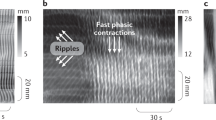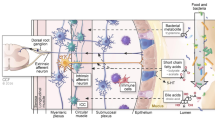Abstract
We developed a mathematical model of colon physiology driven by serotonin signaling in the enteric nervous system. No such models are currently available to assist drug discovery and development for GI motility disorders. Model parameterization was informed by published preclinical and clinical data. Our simulations provide clinically relevant readouts of bowel movement frequency and stool consistency. The model recapitulates healthy and slow transit constipation phenotypes, and the effect of a 5-HT4 receptor agonist in healthy volunteers. Using the calibrated model, we predicted the agonist dose to normalize defecation frequency in slow transit constipation while avoiding the onset of diarrhea. Model sensitivity analysis predicted that changes in HAPC frequency and liquid secretion have the greatest impact on colonic motility. However, exclusively increasing the liquid secretion can lead to diarrhea. In contrast, increasing HAPC frequency alone can enhance bowel frequency without leading to diarrhea. The quantitative systems pharmacology approach used here demonstrates how mechanistic modeling of disease pathophysiology expands our understanding of biology and supports judicious hypothesis generation for therapeutic intervention.





Similar content being viewed by others
References
Lembo A, Camilleri M (2003) Chronic constipation. N Engl J Med 349:1360–1368
Mawe GM, Hoffman JM (2013) Serotonin signalling in the gut–functions, dysfunctions and therapeutic targets. Nat Rev Gastroenterol Hepatol 10:473–486
Bharucha AE (2012) High amplitude propagated contractions. Neurogastroenterol Motil 24:977–982
Bassotti G, Chiarioni G, Vantini I, Betti C, Fusaro C, Pelli MA, Morelli A (1994) Anorectal manometric abnormalities and colonic propulsive impairment in patients with severe chronic idiopathic constipation. Dig Dis Sci 39:1558–1564
Rao SSC, Sadeghi P, Beaty J, Kavlock R (2004) Ambulatory 24-hour colonic manometry in slow-transit constipation. Am J Gastroenterol 99:2405–2416
Narducci F, Bassotti G, Gaburri M, Morelli A (1987) Twenty four hour manometric recording of colonic motor activity in healthy man. Gut 28:17–25
De Schryver AMP, Andriesse GI, Samsom M, Smout AJPM, Gooszen HG, Akkermans LMA (2002) The effects of the specific 5HT(4) receptor agonist, prucalopride, on colonic motility in healthy volunteers. Aliment Pharmacol Ther 16:603–612
Bassotti G (1988) Colonic mass movements in idiopathic chronic constipation. Gut 29:1173–1179
McRorie J, Brown S, Cooper R (2000) Effects of dietary fibre and olestra on regional apparent viscosity and water content of digesta residue in porcine large intestine. Aliment. Pharmacol, Ther
Kiela PR, Ghishan FK (2016) Physiology of Intestinal Absorption and Secretion. Best Pract Res Clin Gastroenterol 30:145–159
Kramer P, Kearney MS, Ingelfinger FJ (1962) The effect of specific foods and water loading on the ileal excreta of ileostomized human subjects. Gastroenterology 42:535–546
Furness JB, Jones C, Nurgali K, Clerc N (2004) Intrinsic primary afferent neurons and nerve circuits within the intestine. Prog Neurobiol 72:143–164
Furness JB (2012) The enteric nervous system and neurogastroenterology. Nature Reviews Gastroenterology and Hepatology 9:286–294
Shin A, Camilleri M, Kolar G, Erwin P, West CP, Murad MH (2014) Systematic review with meta-analysis: highly selective 5-HT4 agonists (prucalopride, velusetrag or naronapride) in chronic constipation. Aliment Pharmacol Ther 39:239–253
Gershon MD (2004) Review article: serotonin receptors and transporters - roles in normal and abnormal gastrointestinal motility. Aliment Pharmacol Ther 20:3–14
Gershon MD, Tack J (2007) The Serotonin Signaling System: From Basic Understanding To Drug Development for Functional GI Disorders. Gastroenterology 132:397–414
Wiesel PH, Norton C, Glickman S, Kamm MA (2001) Pathophysiology and management of bowel dysfunction in multiple sclerosis. Eur J Gastroenterol Hepatol 13:441–448
Dilokthornsakul P, Valuck RJ, Nair KV, Corboy JR, Allen RR, Campbell JD (2016) Multiple sclerosis prevalence in the United States commercially insured population. Neurology 86:1014–1021
Williams R, Rigby AS, Airey M, Robinson M, Ford H (1995) Multiple sclerosis: it epidemiological, genetic, and health care impact. J Epidemiol Community Health 49:563–569
Gulick EE (2010) Comparison of Prevalence, Related Medical History, Symptoms, and Interventions Regarding Bowel Dysfunction in Persons With Multiple Sclerosis. J Neurosci Nurs 42:E12
Weber J, Grise P, Roquebert M, Hellot MF, Mihout B, Samson M, Beuret-Blanquart F, Pasquis P, Denis P (1987) Radiopaque markers transit and anorectal manometry in 16 patients with multiple sclerosis and urinary bladder dysfunction. Dis Colon Rectum 30:95–100
Glick ME, Meshkinpour H, Haldeman S, Bhatia NN, Bradley WE (1982) Colonic dysfunction in multiple sclerosis. Gastroenterology 83:1002–1007
Munteis E, Andreu M, Martinez-Rodriguez J, Ois A, Bory F, Roquer J (2008) Manometric correlations of anorectal dysfunction and biofeedback outcome in patients with multiple sclerosis. Mult Scler 14:237–242
Bassotti G, Villanacci V (2006) Slow transit constipation: a functional disorder becomes an enteric neuropathy. World J Gastroenterol 12:4609–4613
Hasler WL, Saad RJ, Rao SS et al (2009) Heightened colon motor activity measured by a wireless capsule in patients with constipation: relation to colon transit and IBS. Am J Physiol Gastrointest Liver Physiol 297:G1107–G1114
Shah N, Baijal R, Kumar P, Gupta D, Kulkarni S, Doshi S, Amarapurkar D (2014) Clinical and investigative assessment of constipation: A study from a referral center in western India. Indian J Gastroenterol 33:530–536
Wong BS, Manabe N, Camilleri M (2010) Role of prucalopride, a serotonin (5-HT(4)) receptor agonist, for the treatment of chronic constipation. Clin Exp Gastroenterol 3:49–56
Nijsen MJMA, Wu F, Bansal L et al (2018) Preclinical QSP Modeling in the Pharmaceutical Industry: an IQ Consortium Survey Examining the Current Landscape. CPT Pharm Syst Pharmacol 7:135–146
Zineh I (2019) Quantitative systems pharmacology: a regulatory perspective on translation. CPT Pharm Syst Pharmacol. https://doi.org/10.1002/psp4.12403
Peterson MC, Riggs MM (2015) FDA Advisory Meeting Clinical Pharmacology Review Utilizes a Quantitative Systems Pharmacology (QSP) Model: A Watershed Moment? CPT Pharmacometrics Syst Pharmacol 4:e00020
Bliss DZ, Savik K, Jung H, Jensen L, LeMoine M, Lowry A (1999) Comparison of subjective classification of stool consistency and stool water content. Journal of Wound, Ostomy and Continence Nursing 26:137–141
Kay RM, Cohen Z, Siu KP, Petrunka CN, Strasberg SM (1979) Ileal excretion and bacterial modification of bile acids and cholesterol in patients with continent ileostomy. Gut 21:128–132
Rendtorff RC, Kashgarian M (1967) Stool patterns of healthy adult males. Dis Colon Rectum 10:222–228
Heaton KW, Radvan J, Cripps H, Mountford RA, Braddon FE, Hughes AO (1992) Defecation frequency and timing, and stool form in the general population: a prospective study. Gut 33:818–824
Borman RA, Burleigh DE (1995) Functional evidence for a 5-HT2B receptor mediating contraction of longitudinal muscle in human small intestine. Br J Pharmacol 114:1525–1527
Keef KD, Ward SM, Stevens RJ, Frey BW, Sanders KM (1992) Electrical and mechanical effects of acetylcholine and substance P in subregions of canine colon. Am J Physiol 262:G298–307
Hoffman JM, Tyler K, MacEachern SJ et al (2012) Activation of colonic mucosal 5-HT4 receptors accelerates propulsive motility and inhibits visceral hypersensitivity. Gastroenterology 142:844–854
Bouras EP, Camilleri M, Burton DD, Thomforde G, McKinzie S, Zinsmeister AR (2001) Prucalopride accelerates gastrointestinal and colonic transit in patients with constipation without a rectal evacuation disorder. Gastroenterology 120:354–360
Camilleri M, Kerstens R, Rykx A, Vandeplassche L (2008) A placebo-controlled trial of prucalopride for severe chronic constipation. N Engl J Med 358:2344–2354
Poen AC, Felt-Bersma RJ, Van Dongen PA, Meuwissen SG (1999) Effect of prucalopride, a new enterokinetic agent, on gastrointestinal transit and anorectal function in healthy volunteers. Aliment Pharmacol Ther 13:1493–1497
Sloots CEJ, Poen AC, Kerstens R, Stevens M, De Pauw M, Van Oene JC, Meuwissen SGM, Felt-Bersma RJF (2002) Effects of prucalopride on colonic transit, anorectal function and bowel habits in patients with chronic constipation. Aliment Pharmacol Ther 16:759–767
De Lisle RC (2012) Lubiprostone stimulates small intestinal mucin release. BMC Gastroenterol 12:156
Sun X, Wang X, Wang G-D, Xia Y, Liu S (2011) Lubiprostone reverses the inhibitory action of morphine on mucosal secretion in human small intestine. Dig Dis Sci 56:330–338
Barish CF, Drossman D, Johanson JF, Ueno R (2010) Efficacy and safety of lubiprostone in patients with chronic constipation. Dig Dis Sci 55:1090–1097
Beattie DT, Armstrong SR, Vickery RG et al (2011) The pharmacology of TD-8954, a potent and selective 5-HT(4) receptor agonist with gastrointestinal prokinetic properties. Front Pharmacol 2:25
Ratuapli SK, Bharucha AE, Noelting J, Harvey DM, Zinsmeister AR (2013) Phenotypic identification and classification of functional defecatory disorders using high resolution anorectal manometry. Gastroenterology 144:314–322.e2
Faville RA, Pullan AJ, Sanders KM, Smith NP (2008) A biophysically based mathematical model of unitary potential activity in interstitial cells of Cajal. Biophys J 95:88–104
Du P, Poh YC, Lim JL, Gajendiran V, O’Grady G, Buist ML, Pullan AJ, Cheng LK (2011) A preliminary model of gastrointestinal electromechanical coupling. IEEE Trans Biomed Eng 58:3491–3495
Youm JB, Leem CH, Lee SR, Song I-S, Kim HK, Heo HJ, Kim BJ, Kim N, Han J (2014) Modeling of stochastic behavior of pacemaker potential in interstitial cells of Cajal. Prog Biophys Mol Biol 116:56–69
Du P, Paskaranandavadivel N, Angeli TR, Cheng LK, O’Grady G (2016) The virtual intestine: in silico modeling of small intestinal electrophysiology and motility and the applications. Wiley Interdiscip Rev Syst Biol Med 8:69–85
Higgins PDR, Johanson JF (2004) Epidemiology of constipation in North America: a systematic review. Am J Gastroenterol 99:750–759
Camilleri M (1990) Disorders of gastrointestinal motility in neurologie diseases. Mayo Clin Proc 65:825–846
Hinds JP, Eidelman BH, Wald A (1990) Prevalence of bowel dysfunction in multiple sclerosis. A population survey. Gastroenterology 98:1538–1542
Author information
Authors and Affiliations
Corresponding author
Additional information
Publisher's Note
Springer Nature remains neutral with regard to jurisdictional claims in published maps and institutional affiliations.
Electronic supplementary material
Below is the link to the electronic supplementary material.
Rights and permissions
About this article
Cite this article
Das, R., Wille, L., Zhang, L. et al. A quantitative systems pharmacology model of colonic motility with applications in drug development. J Pharmacokinet Pharmacodyn 46, 485–498 (2019). https://doi.org/10.1007/s10928-019-09651-6
Received:
Accepted:
Published:
Issue Date:
DOI: https://doi.org/10.1007/s10928-019-09651-6




